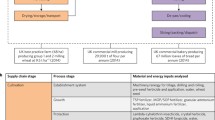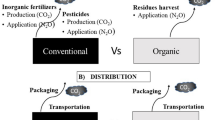Abstract
Purpose
This study of seven foods assessed whether there are modes or locations of production that require significantly fewer inputs, and hence cause less pollution, than others. For example, would increasing imports of field-grown tomatoes from the Mediterranean reduce greenhouse gas (GHG) emissions by reducing the need for production in heated greenhouses in the UK, taking account of the additional transport emissions? Is meat production in the UK less polluting than the import of red meat from the southern hemisphere?
Methods
We carried out a life-cycle inventory for each commodity, which quantified flows relating to life-cycle assessment (LCA) impact categories: primary energy use, acidification, eutrophication, abiotic resource use, pesticide use, land occupation and ozone depletion. The system boundary included all production inputs up to arrival at the retail distribution centre (RDC). The allocation of production burdens for meat products was on the basis of economic value. We evaluated indicator foods from which it is possible to draw parallels for foods whose production follows a similar chain: tomatoes (greenhouse crops), strawberries (field-grown soft fruit), apples (stored for year-round supply or imported during spring and summer), potatoes (early season imports or long-stored UK produce), poultry and beef (imported from countries such as Brazil) and lamb (imported to balance domestic spring–autumn supply).
Results and discussion
Total pre-farm gate global warming potential (GWP) of potatoes and beef were less for UK production than for production in the alternative country. Up to delivery to the RDC, total GWP were less for UK potatoes, beef and apples than for production elsewhere. Production of tomatoes and strawberries in Spain, poultry in Brazil and lamb in New Zealand produced less GWP than in the UK despite emissions that took place during transport. For foods produced with only small burdens of GWP, such as apples and strawberries, the burden from transport may be a large proportion of the total. For foods with inherently large GWP per tonne, such as meat products, burdens arising from transport may only be a small proportion of the total.
Conclusions
When considering the GWP of food production, imports from countries where productivity is greater and/or where refrigerated storage requirement is less will lead to less total GWP than axiomatic preference for local produce. However, prioritising GWP may lead to increases in other environmental burdens, in particular leading to both greater demands on and decreasing quality of water resources.

Similar content being viewed by others
References
AEA, Cranfield University, Moorhouse E, Paul Watkiss Associates, AHDBMS, Marintek (2008) Comparative life cycle assessment of food commodities procured for UK consumption through a diversity of supply chains. Final report for Defra project FO0103, 18 pp and Appendices. http://randd.defra.gov.uk/Default.aspx?Menu=Menu&Module=More&Location=None&ProjectID=15001&FromSearch=Y&Publisher=1&SearchText=FO0103&SortString=ProjectCode&SortOrder=Asc&Paging=10#Description
Barber A, Lucock D (2006) Total energy indicators: benchmarking organic, integrated and conventional sheep and beef farms. Research report number 06/07, ARGOS. Downloaded from www.argos.org.nz
Biel A, Bergström K, Carlsson-Kanyama A, Fuentes C, Grankvist G, Lagerberg Fogelberg C, Shanahan H, Solér C (2006) Environmental information in the food supply system. Report number, ISRN FOI-R-1903-SE. Swedish Defence Research Agency, Defence Analysis, Stockholm, 117 pp
Billiard (2005) Refrigerating equipment, energy efficiency and refrigerants. http://www.iifiir.org/en/doc/1059.pdf
Blanke MM, Burdick B (2005) Food (miles) for thought: energy balance for locally-grown versus imported apple fruit. Environ Sci Poll Res 12:125–127
Buhaug Ø, Corbett JJ, Endresen Ø, Eyring V, Faber J, Hanayama S, Lee DS, Lee D, Lindstad H, Mjelde A, Pålsson C, Wanquing W, Winebrake JJ, Yoshida K (2008) Updated study on greenhouse gas emissions from ships: phase I report. International Maritime Organization (IMO), London
Carlsson-Kanyama A, Ekström MP, Shanahan H (2003) Food and life cycle energy inputs: consequences of diet and ways to increase efficiency. Ecol Econ 44:293–307
Casey JW, Holden NM (2006) Greenhouse gas emissions from conventional, agri-environmental scheme, and organic Irish suckler-beef units. J Environ Qual 35:231–239
Causapé J, Quílez D, Aragüés R (2004) Salt and nitrate concentrations in the surface waters of the CR-V irrigation district (Bardenas I, Spain): diagnosis and prescriptions for reducing off-site contamination. J Hydrol 295:87–100
Coleman K, Jenkinson DS (1996) RothC-26.3—a model for the turnover of carbon in soil. In: Powlson DS, Smith P, Smith JU (eds) Evaluation of soil organic matter models using existing, long-term datasets. NATO ASI Series I, vol 38. Springer, Berlin, pp 237–246
Defra (2008) Guidelines to Defra’s greenhouse gas conversion factors for company reporting. June 2008. Accessed from: http://www.defra.gov.uk/environment/business/envrp/pdf/ghg-cf-guidelines2008.pdf
Foster C, Green K, Bleda M, Dewick P, Evans B, Flynn A, Mylan J (2006) Environmental impacts of food production and consumption: a report to the Department of Environment, Food and Rural Affairs. Manchester Business School, Defra
Garthwaite DG, Thomas MR, Parrish G, Smith L, Barker I (2011) Pesticide usage survey report 224. Arable crops in Great Britain 2008. http://www.fera.defra.gov.uk/plants/pesticideUsage/documents/arable2008.pdf
Goedkoop M, Oele M (2008) Introduction to LCA with SimaPro 7. Pre Consultant, Amersfoort, http://www.pre-sustainability.com/simapro-lca-software
Gonzalez A, Romero E (1991) Influence of pumps on salinity of a coastal aquifer with legal protection (a zone in the north of Isla-Cristina, Huelva, Spain). Water Sci Technol 24:251–260
Guinée JB, Gorrée M, Heijungs R, Huppes G, Kleijn R, Koning A de, Oers L van, Wegener Sleeswijk A, Suh S, Udo de Haes HA, Bruijn H de, Duin R van, Huijbregts MAJ (2002) Handbook on life cycle assessment. Operational guide to the ISO standards. Kluwer Academic Publishers, Dordrecht, The Netherlands
Hospido A, Milá I, Canals L, McLaren S, Truninger M, Edward-Jones G, Clift R (2009) The role of seasonality in lettuce consumption: a case study of environmental and social aspects. Int J Life Cycle Assess 14:381–391
IPCC (2006) Draft 2006 IPCC guidelines for national greenhouse gas inventories
ISO (2006a) ISO 14040: Environmental management—Life cycle assessment—Principles and framework
ISO (2006b) ISO 14040: Environmental management—Life cycle assessment
Lillywhite R, Chandler D, Grant W, Lewis K, Firth C, Schmutz U, Halpin D (2007) Environmental footprint and sustainability of horticulture (including potatoes)—a comparison with other agricultural sectors. Final report of Defra project WQ0101
Lloyd SM, Ries R (2007) Characterizing, propagating, and analyzing uncertainty in life-cycle assessment: a survey of quantitative approaches. J Industr Ecol 11:161–179
MAF (2006b) Sheep and beef monitoring report. A short-term financial and physical forecast reflecting farmer and industry perceptions of farming figures, trends and issues. July 2006. Downloaded from: www.maf.govt.nz/
MAF (Ministry of Agriculture and Food) (2006a) Pipfruit monitoring report a short-term financial and physical forecast reflecting grower and industry perceptions of pipfruit figures, trends and issues in Hawkes Bay and Nelson. April 2006 MAF. http://www.maf.govt.nz/mafnet/rural-nz/statistics-and-forecasts/farm-monitoring/
Mason R, Simons D, Peckham C, Wakeman T (2002) Life cycle modelling CO2 emissions for lettuce, apples and cherries. Report for Department of Transport. Executive summary available at: http://www.dft.gov.uk/pgr/freight/research/coll_lifecyclemodellingco2emissi/lifecyclemodellingco2emissio3226
Matsson B, Wallen E (2003) Environmental LCA of organic potatoes. In: Proceedings of the 26th International Horticultural Congress, ISHS. Acta Hort 619:427–435
Milà i Canals L (2003) Contributions to LCA methodology for agricultural systems. Site dependency and soil degradation impact assessment. PhD Thesis, Universitat Autònoma do Barcelona, Barcelona
Milà i Canals L, Burnip GM, Cowell SJ (2006) Evaluation of the environmental impacts of apple production using life cycle assessment (LCA): case study in New Zealand. Agric Ecosys Environ 114:226–238
Pimentel D, Pimentel M (1996) Food energy and society. CRC Press Taylor & Francis Group Boca Raton, FL, USA
Saunders C, Barber A, Taylor G (2006) Food miles—comparative energy/emissions performance of New Zealand’s agriculture industry. Research Report No. 285. Lincoln University, Canterbury
Schofield R, Thomas DSG, Kirkby MJ (2001) Causal processes of soil salinization in Tunisia, Spain and Hungary. Land Degrad Devel 12:163–181
Smith J, Bradbury N, Glendining M, Smith P (1997) Application to SUNDIAL to simulate nitrogen turnover in crop rotations. Quant Appr Syst Anal 10:87–92
Smith A, Watkiss P, Tweedle G, McKinnon A, Browne M, Hunt A, Treleven C, Naish C, Cross S (2005) The validity of food miles as an indicator of sustainable development. Report for Defra. http://statistics.defra.gov.uk/esg/reports/foodmiles
Torrellas M, Antón A, López JC, Baeza EJ, Pérez Parra J, Muñoz P, Montero JI (2012) LCA of a tomato crop in a multi-tunnel greenhouse in Almeria. Int J Life Cycle Assess 17:863–875
Tukker A, Huppes G, Guinée J, Heijungs R, de Koning A, van Oers L, Suh S, Geerken T, Van Holderbeke M, Jansen B, Nielsen P, Eder P, Delgado L (2006) Environmental impact of products (EIPRO). Analysis of the life cycle environmental impacts related to the final consumption of the EU-25. European Commission Joint Research Centre, EUR 22284 EN, 136 pp. http://ec.europa.eu/environment/ipp/pdf/eipro_report.pdf
van Gijlswijk R, Coenen P, Pulles T, van der Sluijs J (2004) Uncertainty assessment of NOx, SO2 and NH3 emissions in the Netherlands. Rapport nr. R 2004/100. TNO Environment, Energy and Process Innovation, Apeldoorn
Vergé XPC, Dyer JA, Desjardins RL, Worth D (2008) Greenhouse gas emissions from the Canadian beef industry. Agr Syst 98:126–134
Virtanen Y, Kurppa S, Saarinen M, Katajajuuri J-M, Usva K, Mäenpää I, Mäkelä J, Grönroos J, Nissinen A (2011) Carbon footprint of food—approaches from national input-output statistics and a LCA of a food portion. J Cleaner Prod 19:1849–1856
Warner DJ, Davies M, Hipps N, Osborne N, Tzilivakis J, Lewis KA (2010) Greenhouse gas emissions and energy use in UK-grown short-day strawberry (Fragaria xananassa Duch) crops. J Agric Sci 148:667–681
Webb J, Misselbrook TH (2004) A mass-flow model of ammonia emissions from UK livestock production. Atmos Environ 38:2163–2176
Weidema BP, Pedersen RL, Drivsholm TS (1995) Life cycle screening of food products: two examples and some methodological proposals. Akademiet for de Tekniske Videnskaber, Lyngby, 193 pp
Williams AG (2007) Comparative study of cut roses for the British market produced in Kenya and the Netherlands. Cranfield University, Cranfield, Report for World Flowers
Williams AG, Audsley E, Sandars DL (2006) Determining the environmental burdens and resource use in the production of agricultural and horticultural commodities. Main Report. Defra Research Project IS0205. Cranfield University, Bedford
Wolf M-A, Pant R, Chomkhamsri K, Sala S, Pennington D (2012) The International reference life cycle data system (ILCD) handbook. JRC reference reports. Publications Office of the European Union, Luxembourg, 65 pp
Acknowledgments
Many people provided data and contributed to developing the methodology. In particular, we thank Paul Watkiss and Martin Palmer, Agriculture and Horticulture Development Board, Meat Services (AHDBMS); P. Cook and RL Consulting, poultry production in Brazil; and Ø. Buhaug, Norwegian Marine Technology Research Institute (Marintek). Funding from Defra is also gratefully acknowledged.
Author information
Authors and Affiliations
Corresponding author
Additional information
Responsible editor: Gérard Gaillard
Electronic supplementary material
Below is the link to the electronic supplementary material.
ESM 1
(DOCX 23 kb)
Rights and permissions
About this article
Cite this article
Webb, J., Williams, A.G., Hope, E. et al. Do foods imported into the UK have a greater environmental impact than the same foods produced within the UK?. Int J Life Cycle Assess 18, 1325–1343 (2013). https://doi.org/10.1007/s11367-013-0576-2
Received:
Accepted:
Published:
Issue Date:
DOI: https://doi.org/10.1007/s11367-013-0576-2




